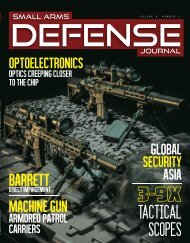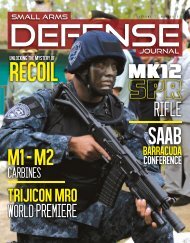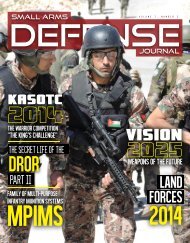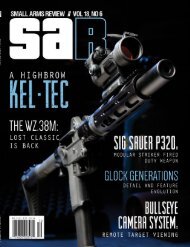SAR 20#2
Create successful ePaper yourself
Turn your PDF publications into a flip-book with our unique Google optimized e-Paper software.
someone transferring an M203 on an AR15 is pretty slim. It is<br />
the flash suppressor/grenade launcher identified in the original<br />
assault weapons ban. Yet, when you ask the administrators at<br />
the state level what is a grenade launcher they cannot explain<br />
that the military flash suppressor is a grenade launcher. One<br />
state in particular when asked to explain the features as applied<br />
in his state told me, “that is a legal question and if you<br />
want an answer you need to hire an attorney and appeal for<br />
an answer to the attorney general’s office”. This was from the<br />
lead detective in charge of the office.<br />
Concerning the practice of pinning a muzzle brake in place,<br />
the purpose of pinning the muzzle brake to the barrel is to<br />
mask the threads. A banned feature is a threaded barrel that<br />
is compatible to accept a military flash suppressor. Once a<br />
muzzle brake or thread protector is pinned in place the barrel<br />
is no longer considered threaded. In all of the research of<br />
all of the state laws and speaking to many personnel not one<br />
has been able to give me a standard of what is considered<br />
permanently attached. If a person were to look for a standard<br />
the best practice would be to use what the ATFE has established<br />
for many years. Permanent attached means: “full fusion<br />
weld (stick, tig, mig) brazing, silver solder that has at least an<br />
1100 degree melting point, blind pin or set screw welded over”.<br />
These methods have always given positive results for permanent<br />
attachment.<br />
TESTING OF A FLASH SUPPRESSOR:<br />
With the enactment of the SAW ban ATFE did not have<br />
a test protocol to evaluate the reduction of flash of a muzzle<br />
attachment, when fired. A protocol was not developed until<br />
2002. This protocol was based on the procedure utilized by<br />
the U.S. Army Test and Evaluation Command at Aberdeen<br />
Proving Grounds. The procedure developed was to compare<br />
the flash of a firearm without a flash suppressor, against the<br />
firearm with the flash suppressor, and any submitted muzzle<br />
attachment for a particular model of weapon. This test<br />
procedure is consistent with the procedure utilized by the<br />
U.S. Army Test and Evaluation Command, Test Operations<br />
Procedure (TOP) 3-2-045.<br />
The following is the test protocol that was developed:<br />
1. A measurement and description is taken of each muzzle<br />
submitted for evaluation. The outside diameter of the<br />
muzzle attachment must be larger than .865 of an inch,<br />
which is the diameter that will accept a muzzle-mounted<br />
grenade.<br />
2. Photographs will be taken of the muzzle attachment<br />
attached to a firearm while being fired in<br />
complete darkness.<br />
3. A grid, measuring 24 inches by 24 inches and made of<br />
1/4-inch metal rod spaced two inches apart, will be placed<br />
4 inches behind and centered on the muzzle attachment.<br />
4. Take three separate sets of test photographs. Two photographs<br />
of each test process.<br />
• The test weapon will be first photographed without<br />
any muzzle attachment.<br />
• The test weapon will then be photographed with the<br />
submitted muzzle attachment.<br />
• The test weapon will then be photographed with the<br />
military style flash suppressor that is a component of<br />
the test weapon.<br />
• The photographs will be compared, using the grid<br />
as a reference, and a determination will be made<br />
as to whether the item is a flash suppressor or<br />
muzzle brake.<br />
• Measure the size of the flash spread of each test fire<br />
by counting the grid lines.<br />
Document the<br />
Camera utilized:<br />
Lens:<br />
Ammunition:<br />
Exposure length:<br />
Distance from camera<br />
lens to muzzle:<br />
Camera: Nikon D80, digital SLR<br />
18-75mm<br />
Federal (Federal ammunition<br />
has been used in all previous<br />
tests)<br />
bulb<br />
60 inches and level to the<br />
muzzle.<br />
Once the test is complete there is not any standard to say<br />
if the flash spread was reduced by so many inches, the muzzle<br />
device would or would not be a flash suppressor. This is<br />
subjective. However, from personal experience military flash<br />
suppressors reduce the flash of a rifle a considerable amount.<br />
It was an eye opener to see just how well many of these flash<br />
suppressors worked. On the other hand there was never a true<br />
muzzle brake capable of reducing the flash a sufficient amount<br />
to be called a flash suppressor.<br />
Conclusion:<br />
Certain states have implemented a SAW ban in an attempt<br />
at a modified gun control. If you reside in one of these states,<br />
or you provide commerce in firearms in one of these states,<br />
and you intend to own or sell firearms, it is imperative you<br />
understand the firearms laws for your state. Failing to do so<br />
could put you in possession of a physical feature of a sporting<br />
firearm of which you could be convicted of a State felony.<br />
WWW.SMALLARMSREVIEW.COM 21 <strong>SAR</strong> Vol. 20, No. 2









